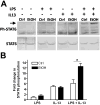Alcohol primes the airway for increased interleukin-13 signaling
- PMID: 19120067
- PMCID: PMC2651991
- DOI: 10.1111/j.1530-0277.2008.00863.x
Alcohol primes the airway for increased interleukin-13 signaling
Abstract
Background: Using an experimental model of airway fibrosis following lung transplantation, we recently showed that chronic alcohol ingestion by donor rats amplifies airway fibrosis in the recipient. Associated with alcohol-mediated amplification of airway fibrosis is increased transforming growth factor beta-1(TGFbeta(1)) and alpha-smooth muscle actin expression. Other studies have shown that interleukin-13 (IL-13) modulates TGFbeta(1) signaling during experimentally-induced airway fibrosis. Therefore, we hypothesized that IL-13 is a component of alcohol-mediated amplification of pro-fibrotic mediators in the alcoholic lung.
Methods: To test this hypothesis, we analyzed tracheal epithelial cells and type II alveolar cells from control- or alcohol-fed rats, alcohol-treated mouse lung fibroblasts, and human bronchial epithelial cells in vitro for expression of various components of the IL-13 signaling pathway. Signaling via the IL-13 pathway was assessed by measuring levels of phosphorylated signal transducers and activators of transcription-6 (STAT6). In addition, we performed heterotopic tracheal transplantation using control-fed and alcohol-fed donor rats and analyzed tracheal allografts for expression of components of the IL-13 signaling pathway by RT-PCR and immunocytochemical analyses.
Results: Interleukin-13 expression was detected in type II alveolar epithelial cells and human bronchial epithelial cells, but not in lung fibroblasts. IL-13 expression was decreased in whole lung and type II cells in response to alcohol exposure. In all cell types analyzed, expression of IL-13 signaling receptor (IL-13R alpha(1)) mRNA was markedly increased. In contrast, mRNA and protein expression of the IL-13 decoy receptor (IL-13R alpha(2)) were decreased in all cells analyzed. Exposure to alcohol also increased STAT6 phosphorylation in response to IL-13 and lipopolysaccharide.
Conclusions: Data from multiple cell types in the pulmonary system suggest that IL-13 and its receptors play a role in alcohol-mediated activation of pro-fibrotic pathways. Taken together, these data suggest that alcohol primes the airway for increased IL-13 signaling and subsequent tissue remodeling upon injury such as transplantation.
Figures





References
-
- Bechara RI, Brown LA, Eaton DC, Roman J, Guidot DM. Chronic ethanol ingestion increases expression of the angiotensin II type 2 (AT2) receptor and enhances tumor necrosis factor-alpha- and angiotensin II-induced cytotoxicity via AT2 signaling in rat alveolar epithelial cells. Alcohol Clin Exp Res. 2003;27(6):1006–14. - PubMed
-
- Bechara RI, Brown LA, Roman J, Joshi PC, Guidot DM. Transforming growth factor beta1 expression and activation is increased in the alcoholic rat lung. Am J Respir Crit Care Med. 2004;170(2):188–94. - PubMed
-
- Bechara RI, Pelaez A, Palacio A, Joshi PC, Hart CM, Brown LA, Raynor R, Guidot DM. Angiotensin II mediates glutathione depletion, transforming growth factor-beta1 expression, and epithelial barrier dysfunction in the alcoholic rat lung. Am J Physiol Lung Cell Mol Physiol. 2005;289(3):L363–70. - PubMed
-
- Boehler A, Estenne M. Post-transplant bronchiolitis obliterans. Eur Respir J. 2003;22(6):1007–18. - PubMed
-
- Boehler A, Kesten S, Weder W, Speich R. Bronchiolitis obliterans after lung transplantation: a review. Chest. 1998;114(5):1411–26. - PubMed
Publication types
MeSH terms
Substances
Grants and funding
LinkOut - more resources
Full Text Sources
Medical
Research Materials
Miscellaneous

